Nashik, one of Maharashtra’s oldest and most spiritual cities, is a perfect blend of history, culture, and faith. From ancient caves to sacred temples, it holds stories that go back thousands of years.
In 2025, with projects like the ₹99 crore ‘Ram-Kal Path’, Nashik is set to welcome even more travellers. With over 1.5 lakh weekend visitors on average, it’s clear this city is a favourite for heritage lovers. In this guide, we’ll explore 13 must-visit historical places in Nashik that take you on a timeless journey.
Here’s a Quick List of Historical Places — Visit in 2025
Here is a quick list of places and how you can plan a visit around these places –
| Sr. No. | Historical Places | Formed in | Historical Significance | Directions |
|---|---|---|---|---|
| 1 | Trimbakeshwar Temple | 1755 to 1786 AD | Dedicated to Lord Shiva | Link |
| 2 | Pandavleni Caves | 2nd century BCE | Buddhist caves | Link |
| 3 | Kalaram Temple | 18th century | Dedicated to Lord Rama | Link |
| 4 | Anjneri Hill | Unknown | Dedicated to Lord Hanuman | Link |
| 5 | Sita Gumpha | Unknown | Goddess Sita’s residence during exile | Link |
| 6 | Muktidham Mandir | 1971 | Religious importance | Link |
| 7 | Shrine of the Infant Jesus | 1970 | Catholic Church | Link |
| 8 | Vijayanand Theatre | 1903 | Related to India’s Freedom Struggle | Link |
| 9 | Tapovan | Unknown | Related to Hindu mythology | Link |
Now, let’s go back in time and get to know where these historical places in Nashik are located, what’s the best time to visit, and how much it will cost you
Before we discuss the specifics, I want to remind you of your social duty toward these historical places. Please remember to maintain decorum and cleanliness, respecting its sanctity.
That being said, let us find the details of Historical Places in Nashik you must visit:
1. Trimbakeshwar Temple
| Historical Significance | Religious and Spiritual Pilgrimage for Hindus |
| Year of Establishment | 1755 to 1786 AD |
| Best time to visit | Year-round, but monsoon season adds a charm |
| Reach Trimbakeshwar Temple | Link |
| Entry Fee | ₹50 for Parking |
Trimbakeshwar Temple is dedicated to Lord Shiva. Legend has it that this is where Lord Shiva released the sacred river (Godavari) from his matted locks. The temple is also one of the 12 jyotirlingas.
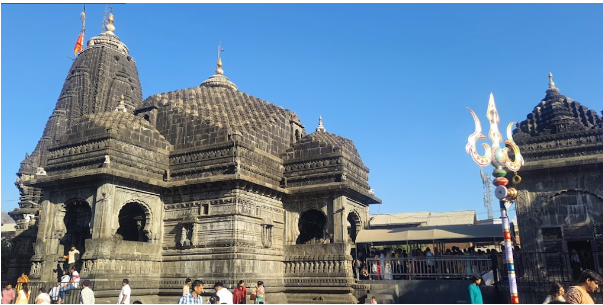
The temple’s unique feature is its three lingams representing Brahma, Vishnu, and Shiva—the holy trinity.
If you plan to visit Trimbakeshwar Temple for Aarti or Puja, I recommend you book your VIP Darshan pass for ₹200 or a pandit for puja on their official website here. This way, you will be able to avoid the long queues.
2. Pandavleni Caves
| Historical Significance | Buddhist caves |
| Year of Establishment | 2nd century BCE |
| Best time to visit | Early morning |
| Reach Pandavleni Caves | Link |
| Entry Fee | ₹20 for Indians and ₹250 for foreigners. |
Pandavleni Caves, also known as the Trirashmi Caves, are carved into the basalt rock on a hill in Nasik. The caves feature intricate carvings, prayer halls, and meditation cells
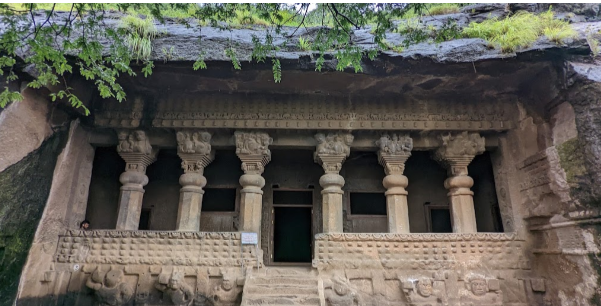
These Buddhist caves served as viharas (monasteries) for monks during the Satavahana period. Emperor Ashoka, the renowned Mauryan king, is also believed to have visited these caves during his reign.
To get to the caves, you will have to hike for 40 mins. Hence, it is recommended that you bring water and snacks. However, be careful not to litter the surroundings.
3. Kalaram Temple
| Historical Significance | A pilgrimage site for Hindu devotees |
| Year of Establishment | 18th century |
| Best time to visit | Early morning or during festivals |
| Reach Kalaram Temple | Link |
| Entry Fee | ₹0 |
Kalaram Temple is a prominent Hindu temple dedicated to Lord Rama. It is known for its striking black stone idol of Lord Rama.
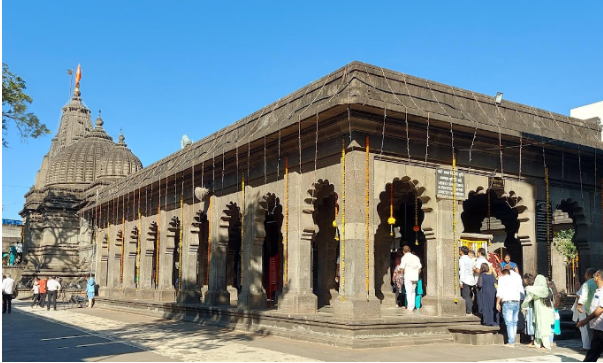
The temple’s architecture showcases a blend of Maratha and Peshwa architectural styles, and its walls are adorned with intricate carvings and sculptures.
The annual Rama Navami festival draws crowds from every corner of the world. However, the approach to this Temple is narrow, and finding a good parking spot is difficult due to the crowds. Hence, I recommend taking a rickshaw to get here.
4. Anjneri Hill
| Historical Significance | Dedicated Lord Hanuman |
| Year of Establishment | Unknown |
| Best time to visit | Sunrise or sunset |
| Reach Anjneri Hill | Link |
| Entry Fee | ₹0 |
Anjneri Hill is believed to be the birthplace of Lord Hanuman. The hilltop offers panoramic views of the surrounding landscape.
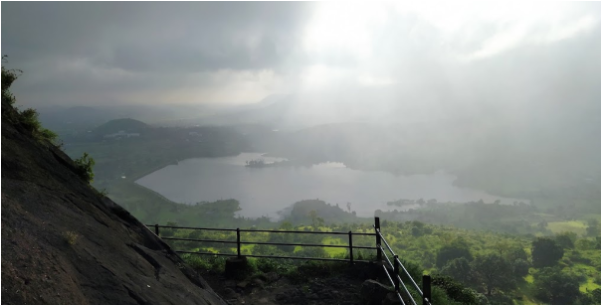
The natural beauty of Anjneri Hill is its most significant feature. The winding path to the top is dotted with ancient trees and shrines.
Devotees visit Anjneri to seek blessings and connect with the spiritual energy of Lord Hanuman.
5. Sita Gumpha (Sita’s Cave)
| Historical Significance | Goddess Sita’s residence during exile |
| Year of Establishment | Unknown |
| Best time to visit | Morning or late afternoon |
| Reach Sita Gumpha | Link |
| Entry Fee | ₹0 |
Sita Gumpha is associated with the epic of the Ramayana. Goddess Sita is believed to have stayed in this cave during her husband’s (Lord Ram) 14-year exile.
Sita Gufa is a natural cave formation with a small temple dedicated to Goddess Sita, her husband Rama, and her brother-in-law Laxman.
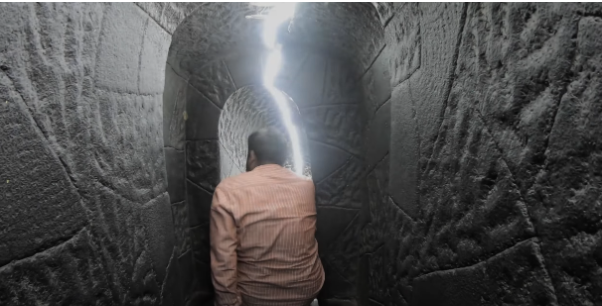
The Kalaram Temple mentioned earlier is only a few meters from Sita Gufa, so plan your trip accordingly.
6. Muktidham Mandir
| Historical Significance | Religious importance to Hindus |
| Year of Establishment | 1971 |
| Best time to visit | Throughout the year, between 6 am to 7 pm |
| Reach Muktidham Mandir | Link |
| Entry Fee | ₹0 |
Shri Muktidham Mandir is a marble temple complex built by Late Sri Jayrambhai Bytco in 1971.
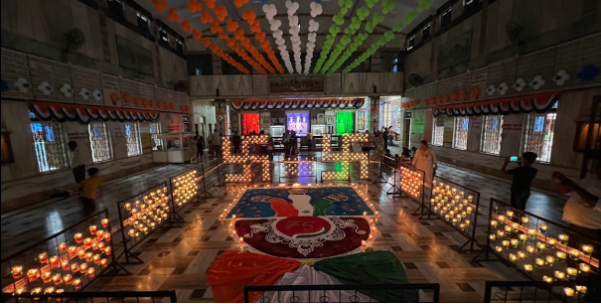
Muktidham Mandir showcases the life and teachings of Swami Samarth, a saint from the Nath tradition.
The temple complex also has idols of major Hindu Gods and Goddesses. These include Goddess Lakshmi, Vishnu,, Sita, Rama, Hanuman, Durga, akshman, and Ganesh. Mukttidham has a Dharamshala that can accommodate at least 200 pilgrims.
7. Shrine of the Infant Jesus
| Historical Significance | Catholic Church |
| Year of Establishment | 1970 |
| Best time to visit | Throughout the year, between 6 am to 9 pm |
| Reach Shrine of the Infant Jesus | Link |
| Entry Fee | ₹0 |
The Shrine of the Infant Jesus is a Catholic church that attracts devotees from all over the region.
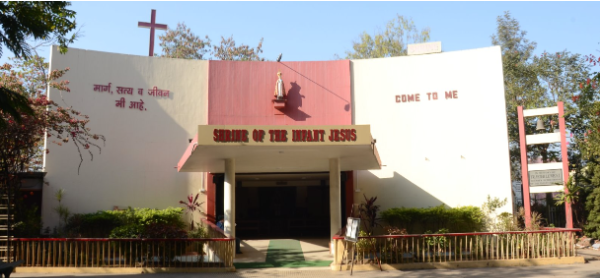
It is known for its beautiful architecture and the miraculous statue of the Infant Jesus, which is believed to have healing powers.
A pilgrim house was constructed recently to accommodate pilgrims. Each room has five beds.
Lodging is available for a maximum of two days during holidays, but longer stays can be considered at other times. Check-in is between 8:00 AM and 8:00 PM.
8. Vijayanand Theatre
| Historical Significance | Indian Cinema and Freedom Struggle |
| Year of Establishment | 1903 |
| Best time to visit | Anytime |
| Reach Vijayanand Theatre | Link |
| Entry Fee | ₹0 |
Vijayanand Talkies witnessed Dadasaheb Phalke’s (the father of Indian Cinema) first film, ‘Raja Harishchandra,’ there.
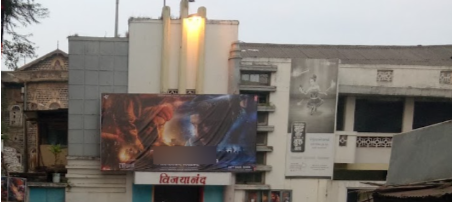
The audience, unfamiliar with moving pictures, mistook it for sorcery and destroyed the projector and tent. Ironically, Vijayanand Talkies entered history even before its official opening.
Years later, in 1909, A 17-year-old student, Anant Laxman Kanhere, shot Jackson at point-blank range in this theater.
9. Tapovan
| Historical Significance | Hindu mythology |
| Year of Establishment | Unknown |
| Best time to visit | Monsoon and winter |
| Reach | Link |
| Entry Fee | ₹0 |
Tapovan is considered a sacred place in Hindu mythology. It is believed to be the site where Lord Rama, Sita, and Lakshmana spent some time during their exile.
The area has several temples and ashrams that attract devotees and spiritual seekers.
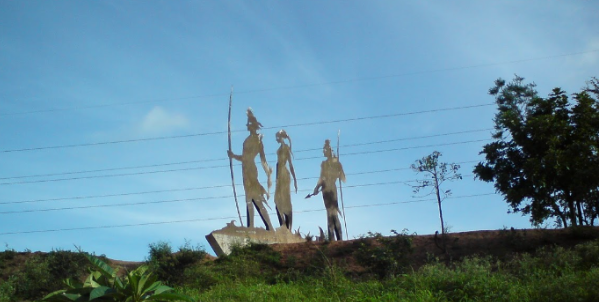
The area is known for its pleasant weather and clean air, making it an ideal destination for nature lovers and outdoor enthusiasts who want to picnic.
Tapovan has also become a popular destination for yoga and meditation retreats. Several ashrams and centers offer programs and workshops led by experienced teachers.
Other Historically Significant Places In Nashik
Nashik is full of rich History. A few other places where History was made are as follows:
- Dada Saheb Phalke Smarak—This is a memorial dedicated to Phalke, popularly known as Dada Saheb Phalke, who is considered the father of Indian cinema. The memorial features a museum that showcases Phalke’s life and work and his contributions to the film industry.
- Ashok Stambh– is a historic pillar believed to have been erected by Emperor Ashoka in the 3rd century BCE.
- Savarkar Vada – is the residence of Vinayak Damodar Savarkar, a prominent Indian independence activist, politician, and writer. This Waada is a fine example of traditional Marathi architecture.
- Shri Navshya Ganpati— a temple built by Anandi Joshi, the first woman to study medicine and become a doctor. Her mansion is a few Kilometers away from the temple. However, entry to the mansion is restricted.
Historical Importance of Nashik
Nashik’s historical significance can be attributed to its mythological, cultural, commercial, and industrial importance, making it a city with a rich and diverse history.
From the Ramayana references to the Mughals, who referred to Nashik as the Garden of Rose (Nashik was earlier known as Gulshanabad), from freedom fighters like Anant Kanhare and Veer Sawarkar back to the Mauryan empire. Nashik has seen it all.
And this is just the gist of Nashik’s history!
Related Reads:
Conclusion- Trimbakeshwar Temple is one of the most historic and sacred places in Nashik
From ancient caves carved into stone to sacred temples echoing with devotion, Nashik offers a rich journey through history and faith. Whether you’re a traveler, a pilgrim, or just curious, these 13 historical places in Nashik promise unforgettable stories and timeless experiences.
In 2025, there’s no better time to explore the soul of this spiritual city. Plan your trip now and let Nashik’s heritage leave you inspired.
FAQs
There is no specific dress code, but modest clothing that covers shoulders and knees is recommended regarding the site’s religious significance.
The best time to visit Nashik is during the winter (October to February) when the weather is pleasant and ideal for exploring the city’s historical sites.
Several guided tours are available for visitors interested in exploring Nashik’s historical sites. However, the quality and management are questionable.
Many of Nashik’s historical sites are located near other attractions or places of interest. For example, the Trimbakeshwar Temple is close to the source of the Godavari River, while the Pandavleni Caves are near Phalke Smarak. Visitors can explore these additional sites during their visit to the historical places.
Most of the historical sites in Nashik are well-maintained and accessible to visitors. However, some sites may have limited accessibility or require visitors to climb stairs or navigate uneven terrain. It is recommended to check with the local authorities or the site’s management for information on accessibility and any special requirements.